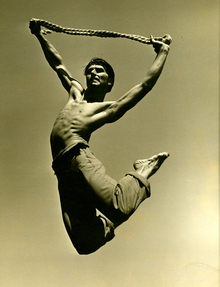Erick Hawkins
| Erick Hawkins | |
|---|---|

Hawkins in El Penitente, 1930s
|
|
| Born |
Frederick Hawkins April 23, 1909 Trinidad, Colorado |
| Died | November 23, 1994 (aged 85) New York City |
| Nationality | American |
| Education |
Harvard University School of American Ballet |
| Known for | Dance and choreography |
| Movement | Modern dance |
| Spouse(s) | Martha Graham (m. 1948-1954; div.) |
| Awards | National Medal of Arts (1994) |
Frederick Hawkins known as Erick Hawkins (April 23, 1909 – November 23, 1994) was an American modern-dance choreographer and dancer
Born in Trinidad, Colorado on April 23, 1909, he majored in Greek civilization at Harvard University, graduating in 1930. A performance by the German dancers Harald Kreutzberg and Yvonne Georgi so impressed him that he went to Austria to study dance with the former. Later, he studied at the School of American Ballet.
Soon he was dancing with George Balanchine's American Ballet. In 1937, he choreographed his first dance, Show Piece, which was performed by Ballet Caravan.
The next year, Hawkins was the first man to dance with the company of the famous modern dancer and choreographer Martha Graham. The following year, he officially joined her troupe, dancing male lead in a number of her works, including Appalachian Spring in 1944. The two were married in 1948. He left her troupe in 1951 to found his own, and they divorced in 1954.
Not long afterwards, he met and began collaborating with the experimental composer Lucia Dlugoszewski. They remained together for the rest of his life.
After leaving the Graham Company, Hawkins' work developed in a unique and different direction. Hawkins moved towards an aesthetic vision detached from realistic psychology, plot, social or political agenda, or simple musical analogue. Important influences were the dances of the American Indians, Japanese aesthetics, Zen thinking, as well as the Greek classics. In some ways, he took dance in a similar direction that abstract painters were taking art, though he disliked the word "abstract." This was coupled with a redefinition of dance technique according to newly understood principles of kinesiology, creating a bridge to later somatic studies. Hawkins' famous statement was “The body is a clear place.”
...
Wikipedia
